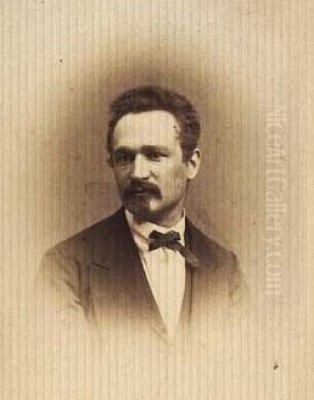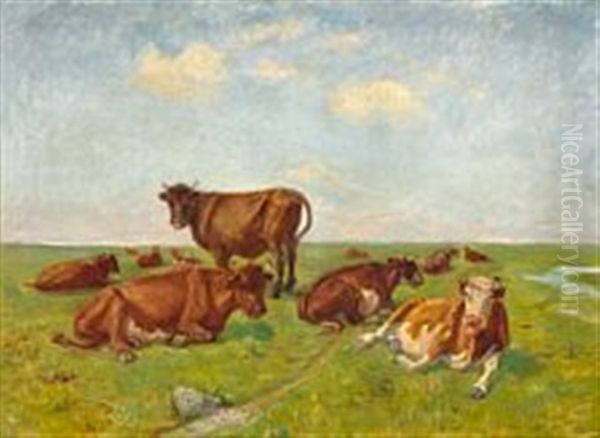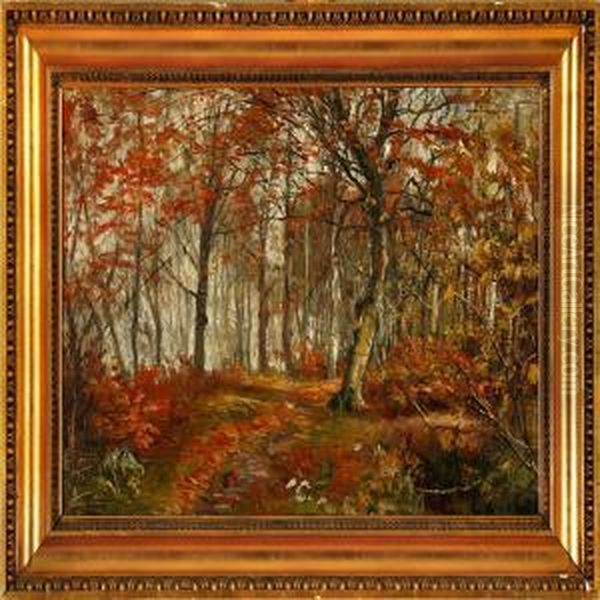An Introduction to a Danish Master

Theodor Esbern Philipsen stands as a pivotal figure in the history of Danish art, celebrated primarily for his role in introducing and adapting Impressionism to a Nordic context. Born in Copenhagen in 1840 and passing away in 1920, Philipsen's life spanned a period of significant artistic transformation in Europe. He distinguished himself through his sensitive depictions of the Danish landscape, his masterful rendering of animals, particularly cattle and horses, and his dedicated exploration of light and atmosphere, hallmarks of the Impressionist movement he came to champion. His work forms a vital bridge between the traditions of the Danish Golden Age and the burgeoning modernism of the late 19th and early 20th centuries.
Philipsen hailed from a culturally engaged merchant family of Jewish heritage in Copenhagen. This environment likely fostered his early appreciation for the arts. From a young age, he displayed a keen interest not only in drawing and painting but also in agriculture and the natural world. This dual fascination would profoundly shape his artistic trajectory, leading him to focus on rural scenes and animal life with an authenticity born of genuine understanding and affection. His connection to the land and its creatures remained a constant throughout his career.
Early Stirrings and Formal Training
The decision to pursue art professionally solidified in Philipsen's youth, partly spurred by encouragement from an older painter named Hans Smith during the 1860s. This guidance helped channel his innate talents towards a dedicated artistic path. Seeking formal instruction, Philipsen enrolled at the prestigious Royal Danish Academy of Fine Arts (Det Kongelige Danske Kunstakademi) in Copenhagen. His time at the Academy was somewhat intermittent, studying there from 1862 to 1863 and again from 1865 to 1869. The academic training provided a foundation, but Philipsen's artistic vision would soon expand beyond its traditional confines.

A crucial phase in Philipsen's development occurred when he traveled to Paris. There, he sought further refinement by studying in the atelier of Léon Bonnat. Bonnat, known for his portraiture and history paintings, represented a more academic tradition. However, being in Paris during the 1870s and early 1880s inevitably exposed Philipsen to the revolutionary ideas and techniques of the French Impressionists. Though not directly studying under figures like Monet or Renoir, the vibrant artistic milieu of Paris left an indelible mark, pushing him towards a freer, more light-focused approach to painting.
Embracing Impressionism in Denmark
Upon returning to Denmark, Philipsen began synthesizing his academic training, his Parisian experiences, and his deep personal connection to the Danish landscape. He became one of the foremost proponents of Impressionism in Denmark, adapting its principles to the unique light and scenery of his homeland. He was particularly drawn to painting en plein air (outdoors), allowing him to directly capture the fleeting effects of natural light, weather, and atmosphere. His canvases often vibrate with the interplay of light and shadow, rendered with increasingly bold and visible brushwork.
Philipsen developed a distinctive style characterized by a keen observation of nature, combined with the Impressionist emphasis on capturing immediate visual sensations. His palette, while influenced by the brighter hues of French Impressionism, often retained a certain Nordic subtlety, reflecting the specific atmospheric conditions of Denmark. He excelled at depicting the changing seasons, the different qualities of light throughout the day, and the dynamic moods of the weather, from serene sunny days to impending storms.
Favourite Haunts: Saltholm and Jægersborg
Certain locations became particularly significant in Philipsen's oeuvre, serving as recurring sources of inspiration. The small, flat island of Saltholm, located in the Øresund strait near Copenhagen, was one such place. Known for its windswept, open landscape and its use as grazing land, Saltholm offered Philipsen vast skies, expansive horizons, and ample opportunities to study animals in their natural environment. His paintings from Saltholm often convey a sense of space, solitude, and the raw beauty of nature, capturing the unique light reflecting off the water and land.
Another favoured location was Jægersborg Dyrehave (Deer Park), a large forested park north of Copenhagen. This area provided a different kind of landscape – ancient trees, dappled sunlight filtering through leaves, and herds of deer. Philipsen frequently painted scenes within the park, exploring the effects of light under the canopy and capturing the elegant forms of the deer. These works showcase his versatility in handling different types of natural settings, from the open plains of Saltholm to the enclosed woodlands of Jægersborg.
Animals as Living Subjects

While an accomplished landscape painter, Philipsen is perhaps equally renowned for his portrayal of animals. Cattle, horses, sheep, and geese feature prominently in his work. Unlike traditional animal painters who might focus on static, detailed portraits, Philipsen depicted animals as integral parts of the landscape, imbued with life and movement. He had an exceptional ability to capture their characteristic postures, behaviours, and interactions within their environment.
His paintings often show cattle grazing peacefully under wide skies, horses pulling ploughs, or geese gathered near water. He rendered them not merely as picturesque elements but as living beings, conveying their weight, texture, and individual presence. His agricultural background undoubtedly gave him an intimate understanding of these animals, allowing him to portray them with both accuracy and empathy. This focus on animal life, combined with his Impressionistic technique, resulted in some of his most dynamic and engaging works.
The Encounter with Gauguin
A significant episode in Philipsen's career was his interaction with the French Post-Impressionist painter Paul Gauguin. Gauguin spent time in Copenhagen between 1884 and 1885, married to a Danish woman, Mette Gad. During this period, he and Philipsen developed a friendship and mutual respect. Gauguin reportedly admired Philipsen's dedication and artistic struggles.
Interestingly, sources suggest that Philipsen, already exploring Impressionist ideas, provided Gauguin with a thorough understanding of Impressionist colour theory and practical techniques during his stay in Denmark. Conversely, Philipsen himself learned from Gauguin, particularly adopting the use of small, distinct, and energetic brushstrokes to build form and convey vibrancy. This exchange highlights Philipsen's engagement with the leading edge of European art and his willingness to both learn from and contribute to the dialogue surrounding modern painting.
Philipsen and His Danish Contemporaries
Theodor Philipsen did not work in isolation. He was part of a vibrant Danish art scene undergoing significant change. His teacher at the Academy, and later an influential figure in his own right, was Kristian Zahrtmann. Zahrtmann, known for his historical paintings and intense use of colour, ran an independent school that nurtured many talents, encouraging individuality while also, perhaps indirectly through his own practice, fostering an interest in bold colour that resonated with Impressionist and Post-Impressionist trends.
Philipsen also interacted with Laurits Tuxen, whom he knew from his time studying in Paris under Bonnat. Tuxen, like Philipsen, embraced aspects of Impressionism, although he became more famous for his large-scale portraits of European royalty. Their shared Parisian experience likely provided common ground for exploring new artistic directions.
Philipsen's work should also be seen in the context of the Skagen Painters, the celebrated artists' colony in northern Jutland. Figures like P.S. Krøyer and Michael Ancher were also deeply invested in capturing the effects of light and depicting scenes of Danish life, albeit often with a greater emphasis on Realism alongside Impressionistic techniques. Michael Ancher, in fact, was reportedly encouraged to pursue painting as a career after seeing Philipsen's work in 1865. Anna Ancher, Michael's wife, was another prominent Skagen painter known for her sensitive studies of light and colour, particularly in interiors.
Influence on the Funen Painters
Philipsen is widely recognized as a crucial precursor and source of inspiration for the group known as the Funen Painters (Fynboerne), who emerged around the turn of the century. This group, including artists like Johannes Larsen, Fritz Syberg, and Peter Hansen, shared Philipsen's dedication to depicting Danish rural life and landscape, often working en plein air. Philipsen is credited with being one of the first artists to truly appreciate and paint the landscapes of Fyns Hoved (Funen's Head), a location that became central to the Funen school.
While artists like Johannes Larsen might have resisted the collective label, their artistic concerns – the focus on everyday rural life, the changing seasons, and the specific light and atmosphere of the Danish countryside – clearly align with the path Philipsen had forged. Philipsen's commitment to direct observation and his Impressionistic rendering of light provided a vital model for this next generation of Danish landscape and genre painters. Peter Hansen, specifically, was known to be influenced by both Zahrtmann and Philipsen.
Other Notable Contemporaries
The artistic landscape of Philipsen's time included other significant figures. Laurits Andersen Ring (L.A. Ring) explored themes of rural life and landscape, often with a Symbolist or Social Realist undercurrent, yet sharing an interest in the specific character of Danish settings. Carl Locher, associated with the Skagen Painters, specialized in dramatic marine paintings. Vilhelm Hammershøi, while stylistically very different with his muted palette and enigmatic interiors, was another major contemporary exploring themes of light and atmosphere. Philipsen also maintained a close friendship with the landscape painter Edvard Petersen, whose style leaned more towards Romanticism. This rich network of artists, with their diverse approaches, underscores the dynamic nature of Danish art during Philipsen's lifetime.
Masterworks and Signature Themes
Several works stand out as representative of Philipsen's style and thematic concerns. Lange Skygger (Long Shadows) exemplifies his fascination with light effects, likely depicting a landscape, possibly with animals, under the low sun of early morning or late afternoon, where elongated shadows become dominant compositional elements, creating mood and defining form. Such works highlight his ability to capture specific moments in time through the careful observation of light.
Hollanderbrønden (The Dutch Well) is another notable landscape, showcasing his treatment of a specific location, likely rendering the scene with his characteristic attention to atmospheric conditions and the textures of the natural environment. The title might allude to historical land reclamation or farming techniques introduced by Dutch settlers in the Amager area near Copenhagen, a region Philipsen often painted.
His numerous depictions of cattle are central to his legacy. Works featuring geese, such as Les Oies, demonstrate his skill in capturing the collective movement and character of these birds. Paintings hinting at dramatic weather, sometimes referred to under titles like Stampede Weather or simply Vejr (Weather), showcase his ability to convey the power and mood of nature, often focusing on animals reacting to changing conditions. These works are marked by vigorous brushwork and a dynamic sense of atmosphere.
Recognition and Later Years
Theodor Philipsen's contributions to Danish art did not go unrecognized during his lifetime. He received several prestigious awards, including the Neuhausenske Prize in 1890 and the Eckersberg Medal in 1915. These honours acknowledged his artistic achievements and his significant position within the Danish art world.
Tragically, Philipsen's later years were marred by a debilitating eye condition. This affliction gradually worsened, eventually making it impossible for him to continue painting. The loss of his ability to practice the art form that had defined his life must have been a profound blow. He passed away in 1920, leaving behind a substantial body of work that had already made a lasting impact.
Enduring Legacy
Theodor Philipsen remains a highly respected figure in Danish art history. He is credited as one of the primary forces behind the introduction and acceptance of Impressionism in Denmark. His unique achievement lay in his ability to filter the techniques and concerns of French Impressionism through a distinctly Danish sensibility, applying them to the landscapes, light, and rural life of his homeland.
His influence extended significantly to the subsequent generation, particularly the Funen Painters, who built upon his legacy of plein air painting and his focus on authentic depictions of the Danish countryside. Philipsen's sensitive portrayal of animals, his masterful handling of light and atmosphere, and his dedication to capturing the essence of the Danish landscape ensure his enduring importance. His work continues to be admired for its honesty, its technical skill, and its quiet yet profound connection to the natural world.